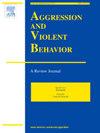动物残忍-事后冒犯关系的发展前因-互惠效应模型
IF 3.4
2区 心理学
Q1 CRIMINOLOGY & PENOLOGY
引用次数: 0
摘要
本文以发展性前因-互惠效应模型的形式,对动物残忍与事后冒犯的关系进行了理论探讨。该模型本身由三个要素(虐待动物、低同理心和道德中立)组成,这些要素被认为是相互双向相关的,并且与某些环境/外部事件和经历单向或双向相关,包括受害、社会学习机会和强化时间表。因此,虐待动物既可以是低同理心的原因,也可以是低同理心的结果,道德中立可能会塑造动物虐待,就像动物虐待可能会塑造道德中立一样,低同理心既可以驱动中和,也可以由中和驱动。当个体从安全的目标和目标移动到更不安全的目标和目标时(小动物→大动物→欺凌→犯罪),模型的顶点(在这个例子中,动物虐待)就会发生进展。提出了一项研究议程,其中使用纵向数据来绘制模型提出的各种关系,并提供评估和干预建议。本文章由计算机程序翻译,如有差异,请以英文原文为准。
A developmental antecedent-reciprocal effects model of the animal cruelty-later offending relationship
This paper offers a theoretical treatise on the animal cruelty-later offending relationship in the form of a developmental antecedent-reciprocal effects model. The model itself consists of three elements (animal cruelty, low empathy, and moral neutralization) believed to be bidirectionally related to one another and either unidirectionally or bidirectionally linked to certain environmental/external events and experiences, to include victimization, opportunities for social learning, and schedules of reinforcement. Hence, animal cruelty can be both a cause and effect of low empathy, moral neutralization is just as likely to shape animal cruelty as animal cruelty is to shape moral neutralization, and low empathy both drives and is driven by neutralization. Progression at the apex of the model (in this case, animal cruelty) occurs as the individual moves from safe targets and objectives to less safe targets and objectives they find more reinforcing (smaller animal → larger animal → bullying → delinquency). A research agenda is laid out in which longitudinal data are used to map the various relationships proposed by the model and recommendations for assessment and intervention are offered.
求助全文
通过发布文献求助,成功后即可免费获取论文全文。
去求助
来源期刊

Aggression and Violent Behavior
Multiple-
CiteScore
7.50
自引率
4.30%
发文量
63
期刊介绍:
Aggression and Violent Behavior, A Review Journal is a multidisciplinary journal that publishes substantive and integrative reviews, as well as summary reports of innovative ongoing clinical research programs on a wide range of topics germane to the field of aggression and violent behavior. Papers encompass a large variety of issues, populations, and domains, including homicide (serial, spree, and mass murder: sexual homicide), sexual deviance and assault (rape, serial rape, child molestation, paraphilias), child and youth violence (firesetting, gang violence, juvenile sexual offending), family violence (child physical and sexual abuse, child neglect, incest, spouse and elder abuse), genetic predispositions, and the physiological basis of aggression.
 求助内容:
求助内容: 应助结果提醒方式:
应助结果提醒方式:


